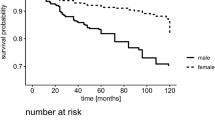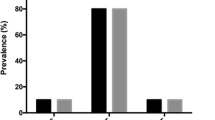Abstract
Introduction
Of the inherited thrombophilias, the Factor V Leiden (FVL) and the prothrombin mutant (FII G20210A) are associated with increased risk of venous thromboembolism (VTE). The C677T mutation of the methylenetetrahydrofolate reductase gene, which may lead to hyperhomocysteinemia, is also considered a risk factor for VTE in some studies. However, the frequency of these genetic risk factors may vary significantly among different populations.
Material and methods
The FVL, FII G20210A and C677T mutations were investigated by PCR-RFLP in 275 young VTE Brazilian patients as well as in 324 biologically unrelated individuals selected to compose the control group.
Results
The C677T mutation in the MTHFR gene was detected in 135 (49.1%) patients, of which 117 (42.5%) were identified as heterozygous and 18 (6.5%) as homozygous. The G20210A mutation was detected in 14 (5.1%) patients in heterozygosis. In both cases, no significant difference was observed when these results were compared to the frequencies observed in the control group. FVL was detected in heterozygosis in 19 (6.9%) patients, corresponding to a significantly increased frequency when compared to that observed for the control group (1.2%) (OR 5.9; 95% CI 2.08–16.79; p < 0.001).
Conclusions
The data indicated that FVL is significantly associated with VTE among young Brazilian patients, but also supported previous evidence that VTE is a multi-factorial disease, resulting from the interaction of genetic and acquired risk factors.
Similar content being viewed by others
References
Collins R, Scrimgeour A, Yusuf S et al (1988) Reduction in fatal pulmonary embolism and venous thrombosis by perioperative administration of subcutaneous heparin. Overview of results of randomized trials in general, orthopedic, and urologic surgery. N Engl J Med 318:1162–1173
Clarke-Pearson DL, DeLong ER, Synan IS et al (1987) Variables associated with postoperative deep venous thrombosis: a prospective study of 411 gynecology patients and creation of a prognostic model. Obstet Gynecol 69:146–150
Samama MM (1993) Epidemiology of risk factors of deep venous thrombosis (DVT) of the lower limbs in community practice: the SIRIUS study. Thromb Haemost 69:763
Bloemenkamp KW, Rosendaal FR, Helmerhorst FM, Buller HR, Vandenbroucke JP (1995) Enhancement by factor V Leiden mutation of risk of deep-vein thrombosis associated with oral contraceptives containing a third-generation progestagen. Lancet 346:1593–1596
Rosendaal FR (1999) Venous thrombosis: prevalence and interaction of risk factors. Haemostasis Suppl S1:1–9
Dahlbaeck B, Carlsson M, Svensson PJ (1993) Familial thrombophilia due to a previously unrecognized mechanism characterized by poor anticoagulant response to activated protein C: prediction of a cofactor to activated protein C. Proc Natl Acad Sci U S A 90:1004–1008
Koster T, Rosendaal FR, de Ronde H, Briet E, Vandenbroucke JP, Bertina RM (1993) Venous thrombosis due to poor anticoagulant response to activated protein C: Leiden Thrombophilia Study. Lancet 342:1503–1506
Bertina RM, Koeleman BPC, Koster T et al (1994) Mutation in blood coagulation factor V associated with resistance to activated protein C. Nature 369:64–67
Poort SW, Rosendaal FR, Reitsma PH, Bertina RM (1996) A common genetic variation in the 3′-untranslated region of the prothrombin gene is associated with elevated plasma prothrombin levels and an increase in venous thrombosis. Blood 88:3698–3703
Frosst P, Blom HJ, Milos R et al (1995) A candidate risk factor for vascular disease: a common mutation in methylenetetrahydrofolate reductase. Nat Genet 10:111–113
Undas A, Domagala B, Jankowski M, Szczeklik A (1999) Treatment of hyperhomocysteinemia with folic acid and vitamins B12 and B6 attenuates thrombin generation. Thromb Res 95:281–288
Franco RF, Santos SEB, Elion J, Tavella MH, Zago MA (1998) The prevalence of the G20210A polymorphism in the 3′-untranslated region of the prothrombin gene in different human populations. Acta Haematol 100:9–12
Rosendaal FR, Doggen CJ, Zivelin A et al (1998) Geographic distribution of the 20210 G to A prothrombin variant. Thromb Haemost 79:706–708
Rodrigues CA, Rocha LKA, Morelli VM, Franco RF, Lourenço DM (2004) Prothrombin G20210A mutation, and not factor V Leiden mutation, is a risk factor for cerebral venous thrombosis in Brazilian patients. J Thromb Haemost 2:1211–1212
Parra FC, Amado RC, Lambertucci JR, Rocha J, Antunes CM, Pena SDJ (2003) Color and genomic ancestry in Brazilians. PNAS 100:177–182
Huber S, Mcmaster KJ, Voelkerding KV (2000) Analytical evaluation of primer engineered multiplex polymerase chain reaction-restriction fragment length polymorphism for detection of factor V Leiden and prothrombin G20210A. J Mol Diagn 2:153–157
Dean AG, Dean JA (1997) Coulombier, D. Epi Info, version 6.04: a word processing database and statistics program for epidemiology on microcomputers. Centre of Disease Control and Prevention, Atlanta
Rosendaal FR, Sicovick DS, Schwartz SM et al (1999) Factor V Leiden (resistance to activated protein C) increases the risk of myocardial infarction in young women. Blood 89:2817–2821
Salomon O, Steinberg DM, Zivelin A et al (1999) Single and combined prothrombotic factors in patients with idiopathic venous thromboembolism: prevalence and risk assessment. Arterioscler Thromb Vasc Biol 19: 511–518
Simioni P, Tormene D, Prandoni P et al (2002) Incidence of venous thromboembolism in asymptomatic family members who are carriers of factor V Leiden: a prospective cohort study. Blood 99:1938–1942
Sabino AP, Ribeiro DD, Carvalho MG, Cardoso J, Dusse LMS, Fernandes AP (2006) Factor V Leiden and increased risk for arterial thrombotic disease in young Brazilian patients. Blood Coagul Fibrinolysis 17:271–275
Voetsch B, Damasceno BP, Camargo EC et al (2000) Inherited thrombophilia as a risk factor for the development of ischemic stroke in young adults. Thromb Haemost 83:229–233
Eichinger S, Pabinger I, Stumpflen A et al (1997) The risk of recurrent venous thromboembolism in patients with and without factor V Leiden. Thromb Haemost 77:624–628
Eichinger S, Weltermann A, Mannhalter C et al (2002) The risk of recurrent venous thromboembolism in heterozygous carriers of factor V Leiden and a first spontaneous venous thromboembolism. Arch Intern Med 162(20):2357–2360
De Stefano V, Martinelli I, Mannucci PM et al (1999) The risk of recurrent deep venous thrombosis among heterozygous carriers of both factor V Leiden and the G20210A prothrombin mutation. N Engl J Med 341:801–806
den Heijer M, Willems HP, Blom HJ (2007) Homocysteine lowering by B vitamins and the secondary prevention of deep vein thrombosis and pulmonary embolism: a randomized, placebo-controlled, double-blind trial. Blood 109:139–144
Cattaneo M, Chantarangkul V, Taioli E, Santos JH, Tagliabue L (1999) The G20210A mutation of the prothrombin gene in patients with previous first episodes of deep-vein thrombosis: prevalence and association with factor V G1691A, methylenetetrahydrofolate reductase C677T and plasma prothrombin levels. Thromb Res 93:1–8
De Stefano V, Rossi E, Paciaroni K et al (2003) Different circumstances of the first venous thromboembolism among younger or older heterozygous carriers of the G20210A polymorphism in the prothrombin gene. Haematologica 8:61–66
Bernstein D, Coupey S, Schonberg SK (1986) Pulmonary embolism in adolescents. Am J Dis Child 140:667–671
Wu O, Robertson L, Langhorne P et al (2005) Oral contraceptives, hormone replacement therapy, thrombophilias and risk of venous thromboembolism: a systematic review. The Thrombosis: Risk and Economic Assessment of Thrombophilia Screening (TREATS) Study. Thromb Haemost 94:17–25
Mohllajee AP, Curtis KM, Martins SL, Peterson HB (2006) Does use of hormonal contraceptives among women with thrombogenic mutations increase their risk of venous thromboembolism? A systematic review. Contraception 73:166–178
Rosendaal FR, Helmerhorst FM, Vandenbroucke JP (2001) Oral contraceptives, hormone replacement therapy and thrombosis. Thromb Haemost 86:12–23
Rosendaal FR, Helmerhorst FM, Vandenbroucke JP (2002) Female hormones and thrombosis. Arterioscler Thromb Vasc Biol 22:201–210
Acknowledgments
This work received financial support from the CNPq, CAPES and FAPEMIG and from the Program “Redes Cooperativas de Pesquisa de Minas Gerais” (RECOPE-MG—REC—32-082/99).
Author information
Authors and Affiliations
Corresponding author
Rights and permissions
About this article
Cite this article
de Paula Sabino, A., Guimarães, D.A.M., Ribeiro, D.D. et al. Increased Factor V Leiden frequency is associated with venous thrombotic events among young Brazilian patients. J Thromb Thrombolysis 24, 261–266 (2007). https://doi.org/10.1007/s11239-007-0024-x
Received:
Accepted:
Published:
Issue Date:
DOI: https://doi.org/10.1007/s11239-007-0024-x




